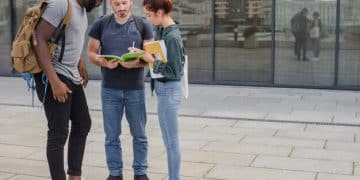How the Criminal Justice System Disproportionately Affects Minority Youth

The criminal justice system in the US frequently impacts minority youth disproportionately through various stages, including arrest, sentencing, and rehabilitation, perpetuating cycles of disadvantage and systemic inequities.
The question of How Does the Criminal Justice System Disproportionately Affect Minority Youth? is not merely academic; it is a profound societal challenge that demands rigorous examination. Across the United States, disparities in justice outcomes persist, casting a long shadow over the lives of young people from marginalized racial and ethnic groups.
Understanding the Foundation of Disparity
The disproportionate impact of the criminal justice system on minority youth is deeply rooted in a complex interplay of historical, social, and economic factors. It is not an anomaly but rather a systemic issue, reflecting ingrained biases and structural inequalities that permeate various levels of society and institutions. To genuinely grasp the scope of this challenge, it is essential to look beyond individual incidents and consider the broader patterns of discrimination and disadvantage. This section will explore the foundational elements contributing to these disparities.
One significant factor is historical injustice. The legacy of slavery, Jim Crow laws, and discriminatory housing policies has created communities that are often under-resourced and over-policed. These historical patterns have
established conditions where minority youth are more likely to encounter law enforcement from a younger age, often for minor infractions that might be overlooked in other demographics. The lingering effects of these policies are evident in the socio-economic conditions found in many minority neighborhoods today.
Socio-Economic Factors and Crime
Poverty, lack of educational opportunities, and inadequate access to mental health services are all powerful predictors of involvement with the criminal justice system. Minority youth often grow up in areas where these resources are scarce, leading to increased vulnerability. For instance, schools in lower-income minority communities may have fewer counselors, social workers, or programs designed to address behavioral issues, pushing children towards disciplinary actions that involve law enforcement.
- Poverty: Limited financial resources can lead to engagement in survival crimes or association with negative influences.
- Education: Underfunded schools and lower educational attainment limit future prospects, often contributing to desperation.
- Healthcare: Lack of access to mental health support can exacerbate underlying issues, leading to problematic behaviors.
- Housing: Residential segregation can concentrate poverty and lead to concentrated efforts by law enforcement.
Moreover, the phenomenon of hyper-policing in minority communities means that minor offenses, which might otherwise go unnoticed or be handled informally in more affluent areas, are often met with formal criminal sanctions. This increased police presence, while sometimes intended to reduce crime, often leads to higher arrest rates for minor offenses, thereby funneling more minority youth into the juvenile justice system. This constant surveillance can also breed distrust between communities and law enforcement, further complicating efforts at crime prevention and rehabilitation.
The School-to-Prison Pipeline
The “school-to-prison pipeline” describes the alarming trend where disciplinary practices in schools, often influenced by zero-tolerance policies, directly push children out of classrooms and into the juvenile justice system. This pipeline disproportionately affects minority youth, who are often subject to harsher disciplinary actions than their white peers for similar behaviors. This phenomenon is a critical component of how the criminal justice system disproportionately affects minority youth, acting as an early and often inescapable entry point into the system.
Zero-tolerance policies, initially intended to address serious threats like weapons or drugs, have expanded to include minor infractions such as dress code violations, truancy, or disruptive behavior. Instead of in-school interventions or restorative justice practices, these policies often mandate suspensions, expulsions, or police involvement. Research continually shows that minority students, particularly Black and Hispanic youth, receive more severe punishments for the same misbehaviors.
Racial Disparities in School Discipline
Data consistently reveals significant racial disparities in school disciplinary actions. Black students, for example, are disproportionately suspended or expelled compared to their white counterparts. This disparity is not always attributable to differing rates of misbehavior but often reflects implicit biases among educators and school administrators.
- Implicit Bias: Unconscious stereotypes held by school staff can lead to harsher judgments and disciplinary actions against minority students.
- Lack of Resources: Schools in low-income areas, often serving predominantly minority students, may lack the resources for alternative disciplinary approaches or mental health support.
- Presence of School Resource Officers (SROs): The increased presence of police officers in schools often leads to behavior being handled as a criminal offense rather than a disciplinary issue within the school setting.
- Discriminatory Policies: Some school policies, while appearing race-neutral, can be applied in ways that unfairly target minority students.
Once a student is suspended or expelled, they are often disengaged from their education, making them more vulnerable to negative influences and involvement with the justice system. The lack of structured activity during suspension can lead to idle time, making them more susceptible to engaging in behaviors that bring them into contact with law enforcement. This early entry into the justice system often sets a trajectory that is difficult to reverse.
Disparities in Arrest Rates and Sentencing
When examining how the criminal justice system disproportionately affects minority youth, the glaring disparities in arrest rates and subsequent sentencing outcomes stand out as critical indicators. These disparities are not simply a matter of differing crime rates but reveal systematic biases that impact every stage of the legal process, from initial police interaction to the final judgment in court. The consequences of these disparities are profound, leading to longer sentences, harsher punishments, and a greater likelihood of recidivism for minority youth.
Even for similar offenses, minority youth are more likely to be arrested than their white peers. This can be attributed to various factors, including concentrated policing in minority neighborhoods, racial profiling, and implicit biases among law enforcement officers. These biases can influence an officer’s decision on whether to make an arrest, issue a warning, or refer a case to diversion programs. The cumulative effect is a pipeline where more minority youth enter the formal justice system.
Sentencing and Judicial Bias
Once arrested, the disparities continue through the judicial process. Minority youth are often less likely to receive leniency, probation, or participation in diversion programs, even when eligible. Instead, they are more often processed through the formal court system, leading to convictions and harsher sentences.
- Plea Bargaining: Minority youth may be less likely to have access to effective legal counsel, leading them to accept unfavorable plea bargains rather than challenging charges in court.
- Mandatory Minimums: Laws with mandatory minimum sentences disproportionately affect minority youth, as judges have less discretion to consider individual circumstances.
- Pre-Trial Detention: Minority youth are more likely to be held in pre-trial detention, which increases the likelihood of conviction and harsher sentencing.
- Judicial Discretion: Even with guidelines, judges still have considerable discretion, and implicit biases can influence sentencing decisions, leading to longer terms of incarceration for minority youth.

The impact of these disparate outcomes extends beyond the individual. It contributes to a cycle of disadvantage, affecting families and entire communities. A criminal record at a young age can hinder future educational opportunities, employment prospects, and overall social mobility, perpetuating systemic inequalities. This early exposure to the justice system creates a sense of profound alienation and distrust, which can be difficult to overcome.
The Role of Implicit Bias and Racial Profiling
Understanding how the criminal justice system disproportionately affects minority youth necessitates a deep dive into the pervasive issues of implicit bias and racial profiling. These two phenomena are not isolated instances of misconduct but deeply embedded aspects of policing and judicial processes that contribute significantly to the unequal treatment of minority youth. While often subtle and sometimes unconscious, their impact is devastatingly real, shaping interactions with law enforcement and influencing judicial outcomes.
Implicit bias refers to the unconscious attitudes and stereotypes that can affect our understanding, actions, and decisions. In the context of the criminal justice system, implicit biases held by police officers, prosecutors, judges, and even jurors can lead to differential treatment of individuals based on their race or ethnicity. For example, an officer might unconsciously perceive a minority youth as more threatening or suspicious than a white youth engaging in similar behavior, leading to increased scrutiny or more aggressive interactions.
Manifestations of Bias
Racial profiling, on the other hand, is a more overt discriminatory practice where law enforcement targets individuals for suspicion of crime based on their race, ethnicity, religion, or national origin rather than on individual behavior. This can manifest in various ways, from routine traffic stops to stop-and-frisk policies, which have historically targeted minority communities.
- Traffic Stops: Minority drivers are frequently pulled over at higher rates than white drivers, often without a clear justification beyond perceived race.
- Stop-and-Frisk: Policies allowing officers to stop and search individuals without probable cause have disproportionately targeted minority youth in urban areas.
- Facial Recognition Technology: The use of this technology, often biased due to training data, can lead to misidentification and wrongful arrests of minority individuals.
- Bail Decisions: Implicit biases can influence decisions about setting bail, leading to higher bail amounts for minority defendants, making it harder for them to secure release.
The consequence of constant racial profiling and biased interactions is not only an increased likelihood of arrest for minority youth but also a profound erosion of trust in law enforcement. Young people who are repeatedly stopped, searched, or questioned without cause develop a sense of cynicism and alienation, which can hinder community cooperation and crime prevention efforts. This erosion of trust further entrenches the cycle of disproportionality within the justice system. Addressing these biases requires comprehensive training, accountability measures, and a fundamental shift in policing strategies.
Consequences and Long-Term Impact
The disproportionate involvement of minority youth in the criminal justice system carries severe and far-reaching consequences, extending well beyond the immediate legal ramifications. The long-term impact on individuals, families, and communities is profound, perpetuating cycles of disadvantage and hindering social mobility. Understanding these consequences is crucial for appreciating the full scope of how the criminal justice system disproportionately affects minority youth and for developing effective interventions.
For the individual youth, a brush with the criminal justice system, even for minor offenses, can mark them permanently. A criminal record, even a juvenile one, can significantly limit future opportunities. This includes challenges in securing employment, as many employers conduct background checks and may be reluctant to hire individuals with a criminal history. It can also impede access to higher education, with colleges and universities often asking about past legal troubles on applications, and some federal financial aid programs having restrictions for those with drug-related convictions.
Societal and Familial Repercussions
Beyond individual prospects, the consequences ripple through families and communities. When a young person is incarcerated, their family often bears the emotional and financial burden. Families may struggle with legal fees, visitation costs, and the emotional toll of having a child in detention. This can destabilize families and create additional stressors, particularly in already vulnerable communities.
- Reduced Earning Potential: A criminal record significantly lowers lifetime earning potential, contributing to intergenerational poverty.
- Mental Health Issues: Involvement in the justice system can lead to increased rates of depression, anxiety, and PTSD among youth, especially those subjected to harsh treatment.
- Social Stigmatization: Labeling a youth as “criminal” can lead to social exclusion, making it difficult to reintegrate into society and fostering a sense of hopelessness.
- Civic Disengagement: Formal justice involvement can lead to disenfranchisement and a reluctance to participate in civic life, further marginalizing communities.

At a societal level, the disproportionate incarceration of minority youth represents a massive waste of human potential. Instead of contributing productively to their communities, these young people are often trapped in a cycle of confinement and disadvantage. This not only burdens taxpayers but also undermines the social fabric, fostering distrust and cynicism in institutions that are meant to serve and protect all citizens. Addressing these long-term consequences requires not just legal reform but also comprehensive social and economic investments in affected communities.
Pathways to Reform and Equity
Addressing how the criminal justice system disproportionately affects minority youth requires a multi-faceted approach, emphasizing comprehensive reform and a renewed commitment to equity. This is not simply about tweaking existing policies but about reimagining the entire system to ensure fairness, reduce harm, and promote rehabilitation, especially for young people. The pathway to reform involves a concerted effort from policymakers, law enforcement, educators, and communities to dismantle the structural inequalities that perpetuate these disparities.
One critical area for reform is the re-evaluation and overhaul of zero-tolerance policies in schools. Instead of resorting to suspensions and expulsions, schools should adopt restorative justice practices, conflict resolution programs, and increased access to mental health services. This approach seeks to address the root causes of misbehavior and keep students engaged in their education, thereby reducing their likelihood of entering the criminal justice system.
Diverting Youth from the System
Beyond schools, a significant reform priority is the expansion of diversion programs. Rather than automatically sending youth through the formal court system, minor offenses can be addressed through community-based alternatives, counseling, or mediation. These programs offer a chance for rehabilitation without the stigmatizing effects of a criminal record, allowing youth to develop positively.
- Police Decarceration: Training police to use discretion, de-escalation techniques, and community-based solutions instead of immediate arrest for minor infractions.
- Pre-Arrest Diversion: Programs that allow youth to avoid arrest and formal charges by participating in restorative justice or community service.
- Alternatives to Incarceration: Expanding options like electronic monitoring, intensive probation, and therapeutic interventions for youth who would otherwise be detained.
- Sentence Reform: Revisiting mandatory minimum sentences and giving judges more discretion to consider individual circumstances and rehabilitation potential.
Furthermore, addressing implicit bias and racial profiling within law enforcement is paramount. This includes implementing bias training, diverse recruitment efforts, and robust accountability mechanisms for officers who engage in discriminatory practices. Data collection on arrests and sentencing by race can also provide crucial insights, allowing communities to monitor disparities and advocate for targeted interventions. Ultimately, creating a more equitable system means investing in communities, providing resources that uplift rather than penalize, and ensuring that justice truly means fair treatment for all youth, regardless of their background.
| Key Aspect | Brief Description |
|---|---|
| 🏫 School-to-Prison Pipeline | Zero-tolerance policies and implicit biases in schools push minority youth into the justice system. |
| 🚨 Arrest & Sentencing Bias | Minority youth face higher arrest rates and harsher sentences for similar offenses compared to peers. |
| ⚖️ Implicit Bias & Profiling | Unconscious biases and racial profiling by law enforcement contribute to disproportionate outcomes. |
| 🔄 Long-Term Impact | Criminal records create barriers to education, employment, and overall social mobility for affected youth. |
Frequently Asked Questions About Disproportionate Justice
In this context, “disproportionately affect” means that minority youth are impacted by the criminal justice system at rates higher than their representation in the general population, or receive harsher treatment for similar offenses compared to their non-minority counterparts. This suggests systemic biases rather than purely individual actions.
Research consistently shows that while crime rates do vary, the disproportionate impact is not primarily due to higher rates of offending among minority youth. Instead, it’s largely attributed to factors like concentrated policing in minority communities, racial profiling, implicit biases in the justice system, and the “school-to-prison pipeline.”
The “school-to-prison pipeline” refers to policies and practices that push students, especially minority youth, out of schools and into the criminal justice system. Zero-tolerance discipline, increased police presence in schools, and the disproportionate application of harsh punishments contribute to this pipeline, channeling young people toward arrest rather than educational support.
Long-term consequences include significant barriers to education and employment due to a criminal record, even for juvenile offenses. It can also lead to mental health issues, social stigmatization, and a reduced likelihood of civic engagement, perpetuating cycles of poverty and disadvantage for individuals and their families into adulthood.
Key reforms include ending zero-tolerance policies in schools, expanding restorative justice and diversion programs, implementing bias training for law enforcement and judicial officials, and investing in community-based initiatives that support youth. These measures aim to reduce incarceration and provide equitable opportunities for all young people.
Conclusion
The disproportionate impact of the criminal justice system on minority youth is a complex and deeply ingrained issue in the United States, stemming from a confluence of historical injustices, socio-economic disparities, and systemic biases within law enforcement and judicial processes. It is a reality that demands a comprehensive and empathetic response, moving beyond superficial fixes to address the root causes of inequality. By understanding the intricate mechanisms through which these disparities manifest, from the school-to-prison pipeline to implicit bias in sentencing, we can begin to forge pathways toward a more equitable and just society. The shift towards restorative justice, diversion programs, and genuine community investment offers a beacon of hope, promising a future where all youth, regardless of their background, are given the opportunity to thrive without the shadow of systemic injustice. Addressing this issue is not merely a matter of legal reform; it is a moral imperative, essential for building stronger communities and upholding the promise of equal justice under the law for every individual.





